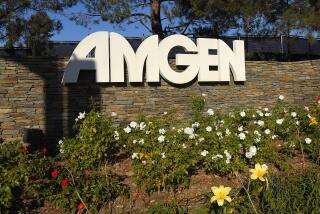Dow Chemical to Get Control of Marion Labs : $5-Billion-Plus Deal Is an Effort to Diversify
- Share via
As part of a prescription to diversify beyond its core chemical businesses, Dow Chemical Co. agreed Monday to acquire 67% of pharmaceutical maker Marion Laboratories Inc. in a deal valued at $5.2 billion to $5.7 billion.
The proposed deal--the latest and possibly the largest transaction in a series of drug company mergers--would marry Dow’s research capability with Marion’s savvy marketing and its successful heart drug Cardizem and ulcer drug Carafate, analysts and company officials said.
“It’s an ideal marriage of companies that have strengths complementary to each other,” said Larry W. Wheeler, a spokesman in Marion’s Kansas City, Mo., headquarters.
The deal, subject to board and shareholder approvals, would combine Dow’s Cincinnati-based Merrell Dow Pharmaceuticals Inc. unit with Marion to create a new publicly traded company to be called Marion Merrell Dow Inc., based in Kansas City.
Marion Founder Approves Deal
Under terms of the unusual deal, Dow would make a tender offer of $38 a share, or $2.3 billion, for about 39% of Marion’s 155 million shares outstanding. Following that, Marion would issue new shares to Dow, and Dow would transfer Merrell Pharmaceuticals and a new class of Dow securities to Marion shareholders. The new securities would be paid to Marion shareholders in either 1991 or 1992, depending on the value of Marion common stock at the time.
The deal won the approval of Marion Chairman Ewing M. Kauffman, who founded the company in 1950 and who with his family controls 23% of Marion’s stock.
Analysts saw the deal as part of a continuing consolidation in the drug business, spurred by Eastman Kodak Co.’s $5.2-billion takeover of Sterling Drug in 1988. A few months ago, SmithKline Beckman Corp. merged with Beecham Group PLC of Great Britain, creating the second-largest pharmaceutical company in the world.
“It’s an extremely expensive business to be in,” said Mark Yockey, an industry analyst with Waddell Reed in Kansas City, Mo. “The amount of money you must spend on R&D; and marketing is immense, and to do that you have to be big, and to be big, you have to merge.”
For Marion, the deal would inject new products into a company that faces stiff competition from generic drugs when exclusivity expires in November, 1992, on its biggest seller, the heart drug Cardizem. Analysts expect it to account for $600 million in sales for 1989, up from $441 million in 1988.
Cardizem and the ulcer drug Carafate, with expected 1989 sales of $200 million, account for nearly 90% of the company’s sales. Marion recently received federal approval for a new formulation of Cardizem for use by high-blood-pressure patients, which is expected to increase the drug’s sales.
Exclusivity expired in 1986 on Carafate, although no competitors have yet emerged, a Marion spokesman said.
The deal would also afford Marion access to foreign markets, analysts said.
No Mass Layoffs
For Dow, the merger would give Merrell access to Marion’s highly regarded marketing and distribution system, including a field sales force of 750.
“It fits very well with Merrell Dow, because there are good product names with Merrell,” said analyst Scott Stephenson of B. C. Christopher Securities in Kansas City.
Merrell’s biggest sellers are the antihistamine Seldane, the anti-smoking gum Nicorette and the cholesterol-lowering medication Lorelco.
Management of the new company will be drawn from both Merrell and Marion, Wheeler said. Neither company expected mass layoffs as a result of the merger.
In June, Marion acquired nearly 20% of the research firm American Bio Science for $15 million, Wheeler said.
In New York Stock Exchange trading, Marion shares soared $8.25 to $33.50; Dow shares fell $1.50 to $88.375.
More to Read
Inside the business of entertainment
The Wide Shot brings you news, analysis and insights on everything from streaming wars to production — and what it all means for the future.
You may occasionally receive promotional content from the Los Angeles Times.










